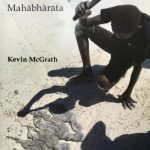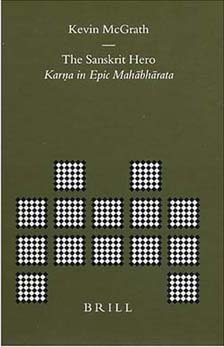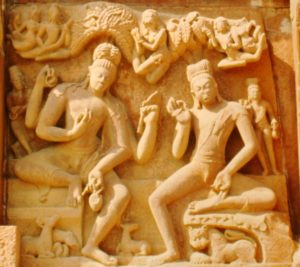Kevin McGrath: Vyasa Redux—Narrative in Epic Mahabharata, Anthem Press, London, 2020, pp.121

This is the 8th book by Dr. McGrath of Harvard University investigating different aspects of the Mahabharata, supplementing his 2011 book, Jaya: Performance in Epic Mahabharata. Intriguingly titled, it studies in detail the multiple roles played by this seer-poet who composes and participates in this autobiography which is also the biography of his descendants, turning the narrative into “a facsimile of (human) consciousness.”
Vyasa and Sanjaya are the only two dramatic persons who are also creative poets. It is true that Bhishma displays no dramatic persona in the two Books of Peace and Instruction (Shanti and Anushasana). In the former, however, McGrath overlooks the tragic persona of Vyasa himself desperately seeking his beloved son Shuka in vain.
It is Vyasa who gifts Sanjaya supernatural sight, inspires Bhishma to instruct, grants Gandhari sight of the corpses in Kurukshetra and shows blind Dhritarashtra his slaughtered kith and kin (akin to Odysseus’ viewing of the dead heroes, with Achilles silently turning away from him, whereas the Pandavas are reconciled with Karna). Yudhishthira will encounter them again twice over in Naraka and Svarga. Vyasa’s sudden appearances and disappearances always direct the plot and impact the emotions of characters. Sanjaya explicitly attributes his audio-visual experience of the Gita to Vyasa’s grace. Bhishma’s hymn to Krishna repeats what he had heard from Vyasa. The interlinking of Dvaipayana-Krishna and Vasudeva-Krishna is profoundly significant, as is that of Ganga-born Bhishma and Yamuna-island-born Vyasa. Vyasa is the only epic poet to move even to Svarga. In the Stri Parva he hears Vishnu telling the Earth how the kings would slaughter one another at Kurukshetra (it is not the Earth who forecasts this, as McGrath writes on p. 62), lending a cosmic inevitability to the happenings. In McGrath’s words, he is “a literary super-catalyst affecting the plot variously” and functions like Athena in the Odyssey, virtually like a director-cum-script-writer-cum-actor. Adept at flashbacks as well as flash-forwards, he is gifted with both foresight and hindsight. His absence from the crucial Sabha Parva (and Krishna’s during the dice-game), Virata Parva (Krishna is absent too) and the Udyoga Parva (but for two by-the-way interjections) is a feature that needed further. Vyasa also presides at four (not three vide p. 81) critical rituals: the royal anointing; the war as yajna; the horse-sacrifice and the snake-holocaust.
While Vyasa is “an acutely polymorphic and multi-textual figure” whose personal is only approximated by Homer’s Athena, both the Mahabharata and the Odyssey are polytronic. The unity is not of time but of narrative structure. Human time is quite vague in both except for the 18 days of the Kurukshetra War. The forest exile and the Shanti and Anushasana Parvas seem to be timeless. By ending with the snake-sacrifice where the epic was first recited, the poem creates cyclical “poetic time”. Both epics are also “multi-texts”, made up of numerous traditions (historical, geographical, social, mythological etc.) that are different yet coherent.
The structure of the Mahabharata is possibly the most complicated of any epic. Ugrashrava Sauti narrates to rishi Shaunaka and his monks what he heard Vaishampayana recite at Janamejaya’s snake-sacrifice at Takshashila as Vyasa had taught him (McGrath erroneously places it in Afghanistan, vide pp. 23, 46, instead of Northwest Pakistan). Sauti had also heard it from his father Lomaharshana. Further, we hear all this from a nameless rhapsode. So we have: anonymous rhapsode-> Sauti-> Lomaharshana-> Vaishampayana-> Vyasa. In the Odyssey it is: poet-> Muse-> Zeus-> Athena (who, unlike Vyasa, is a shape-shifting narrator and actor)-> Odysseus. Within these concentric circles there are numerous other narrators: Sanjaya in the Udyoga and the war books; Markandeya and Lomasha in the forest-exile; Bhishma primarily in the Udyoga, Shanti and Anushasana Parvas; Narada and Vyasa himself. The entire narrative is an extended flashback, artistically so rendered that the events acquire an immediacy. The narrative repeatedly moves back and forth. For instance, the tale of Shakuntala and her son the eponymous Bharata precedes the chronologically anterior account of Yayati and his sons. Again, despite prophesies, protagonists lose awareness of these and proceed to take decisions that are character-driven, yet fulfil what has been foretold. Beginning with Yayati the great ancestor of the clans, this persists right up to Janamejaya’s sacrifice that was foretold to remain incomplete.
McGrath makes the very interesting point that Sauti’s summary (Parvasangraha) mentions 23,783 slokas for the war books including the Sauptika, approximating the 24,000 of the Jaya that Vyasa composed first. Sanjaya narrating the War Books is akin to the Greek aoidos, a poet of preliterate Bronze Age times, while Vaishampayana is a rhapsode of the literate period. The archaic war books became the Maha-Bharata through Vyasa’s act of supreme dhyana. It is very interesting that for this act of poetic inspiration McGrath should find an analogy in Bob Dylan who felt that his songs came to him from somewhere else. Sri Aurobindo has documented at length the process of poetic inspiration for his Savitri. Dhyana is also an act Bhishma performs before instructing Yudhishthira. Krishna’s Gita is divine afflatus. The evolution of the epic’s plot seems to be through meditative experiences of these three. Added to this is Krishna’s theophany in the Hastinapura court and on the battlefield. These, argues McGrath, “supply the core narrative poem with its ethical and spiritual force.” In enumerating Krishna’s strategies he overlooks the pains taken over Drona’s killing. He claims there is no solemn ritual (p. 27) despite the repeated extolling of yajnas.
The preliterate traditions that were compiled into one epic in classical times covered a vast geography to supersede specific locales and regimes for appealing to the commonalty, becoming “geopolitically uniform”. McGrath ascribes to this the absence of references to Buddhism, that was surely contemporary, to the heritage of the Harappan Civilization, to idol-worship and to money. The epic world is artificial, not reflecting material reality. Even the weather and physical details about characters are left vague. There are five places that are particularly important: Hastinapura, Indraprastha (curiously unoccupied by the Pandavas post-war, as Rama’s sons abandoned Ayodhya), the forest, Matsya and Kurukshetra. Although the last features as a field of blood (beginning with Parashurama celebrating his massacre of Kshatriyas in five pools called samantapanchaka), its initial fame is because Brahma performed a yajna there. Later Raja Kuru obtained the boon that Svarga was assured to anyone dying there, Krishna recited the Gita and Bhishma instructed Yudhishthira from the bed-of-arrows. Dvaraka should be added as significant because Krishna commutes between it and wherever the Pandavas are.
Despite the rivers of blood that flow, Homer and Vyasa’s poetry encapsulates it in similes and metaphors that invest death with beauty (note that Sauti begins with the tree image for the epic and the warring fraternities). Vyasa goes further than Homer and shows us the heroes beyond death glorious in Svarga. Neither does Homer have the very powerful moral dimension that Vyasa stresses repeatedly as his poem’s efficacy. Again, although the Iliad covers forty days and the Odyssey decades, there is little significance day-wise in either.
McGrath makes the very important point that Kshatriya lineages found in the Mahabharata are actually of matrilineal descent as all males had been killed by Parashurama and the women approached Brahmins for progeny. Vyasa’s direct descendants through Dhritarashtra are wiped out too. Janamejaya, descended from Yayati’s eldest son Yadu’s lineage through Subhadra, rules in Hastinapura and Indraprastha is given to Vajra, Yadava Krishna’s descendant. Thus, the bheda, division, that started when the youngest son Puru replaced the eldest Yadu is ended, lending another cyclical dimension to the epic.
McGrath argues that till the war ends the type of governance portrayed is fraternal (he cites the modern example of Saudi Arabia), what Romila Thapar calls “a lineage society”, whereas the Shanti Parva features a later development: the classic monarchic state instead of oligarchic rule. However, if in the Iliad Agamemnon’s word is final, is that not true for Duryodhana and Yudhishthira as well? In both the Homeric and Indian epics, it is women who drive the plot: Helen, Chryseis, Briseis, Circe, Calypso, Penelope, Kaikeyi, Sita, Satyavati, Kunti, Gandhari. McGrath erroneously states that Draupadi, Sita and Penelope conduct svayamvaras to select a husband. It is actually viryashulka: the bride is the prize to be won in an archery contest. Helen’s marriage is an exception.
Bhishma’s lengthy discourse on peace and donating does not preclude war. Immediately thereafter, preceding the horse-sacrifice, is the Anugita by Krishna to Arjuna and then Arjuna’s battles accompanying the roving steed, paralleling the Gita and the Kurukshetra war. As McGrath points out, the vision of the Anugita and the society pictured in the Shanti and Anushasana Parvas is far from the Vyasan weltanschauung of the Gita and the Sabha Parva.
There is a very significant transition that usually goes unnoticed which McGrath mentions. Hearing of the living meeting the dead who emerge from the Bhagirathi, Janamejaya wishes to see his dead father. Suddenly, the narrator is no longer Vaishampayana. The anonymous reciter states, Sauti reporting that through dhyana (misspelled as “mediation” on p. 67 instead of “meditation”) Vyasa produced Parikshit.
In the very first book Sauti flashed forward to report Dhananjaya’s plangent lament to Sanjaya listing the key events of the plot even before the Mahabharata had begun to be recited. As McGrath writes, “it is absolutely proleptic.” On the basis of these first two books being largely in prose, McGrath feels that they are “editorial addition” setting the stage for the recitation at Takshashila. However, that is not where Vyasa composed and declaimed it as McGrath states on p.73. We are never told where Vyasa composed it, only that it took him three years. The Pauloma Parva is a fresh beginning, reporting Sauti’s arrival at Bhargava Shaunaka’s ashram, where he launches into a recital of the Bhrigu lineage (whence Sukthankar’s theory about the Bhargava Brahmins being the editors of the Mahabharata). Sauti further states having heard the story of Astika, composed by Vyasa, from his father Lomaharshana, Vyasa’s disciple, as he recited it to sages in the Naimisha forest. Thus, yet another concentric circle of narration is added. Although, initially, Sauti stated that its first public declamation was by Vaishampayana at Vyasa’s bidding to recite the poem of bheda (division), after the Astika Parva he states that during intervals of the snake-sacrifice Brahmins told Vedic tales while Vyasa recited the Bharata. Vaishampayana tells Janamejaya that he will tell how the bheda arose out of the dice-game for sake of the kingdom, the forest-exile and the war—the three crucial stages of the epic—and provides a summary (a fifth one) that, curiously, omitting the rajasuya yajna, ends with Duryodhana’s death and the Pandavas’ jaya (victory) that completes the tale of bheda. Vaishampayana’s own beginning is with the tale of Uparicara Vasu, father of Matsyagandha. These several beginnings are evidence of “editorial bricolage”, writes McGrath, seeking to include all possible traditions. The narrative repeatedly moves back and forth. For instance, the tale of Shakuntala and her son, the eponymous Bharata, precedes the chronologically anterior account of Yayati and his sons.
Janamejaya puts several questions to Vaishampayana before the recital begins: why the mighty Pandavas tolerated the misery inflicted; why Bhima controlled his rage; why Draupadi did not consume the Dhartarashtras; why the brothers obeyed Yudhisthira though cheated; why Yudhishthira bore undeserved wretchedness; why invincible Arjuna, with Krishna as charioteer, suffered so much? McGrath does not examine why these six questions are never answered. Surely, this is a moot question.
McGrath mentions with admiration the retellings by Shashi Tharoor (The Great Indian Novel) and Karthika Nair (Until the Lions). Amreeta Syam’s long poem “Kurukshetra” should be added to these. While quoting approvingly from Girja Kumar’s study The Mahabharatans, he could also have referred to Krishna Chaitanya (K.K. Nair)’s superb work The Mahabharata—a literary study. McGrath ends with a splendid discussion of the Odyssey (and a brief but insightful overview of the Iliad celebrating the Karna-like Achilles intent upon earning fame) drawing out the similarities in theme and structure with the Mahabharata. In all three epics the deaths of the heroes are foretold, but the Homeric poems do not include their deaths. Both are concerned not merely with a multi-dimensional narrator and a hero but also with family dynamics and divine agency. The template they follow is similar. McGrath’s work of just 104 pages with a striking cover and beautifully printed is densely packed with rich insights and is an immensely rewarding read.
cf. https://epaper.thestatesman.com/3357170/Kolkata-The-Statesman/20TH-JANUARY-2022#page/11/1

